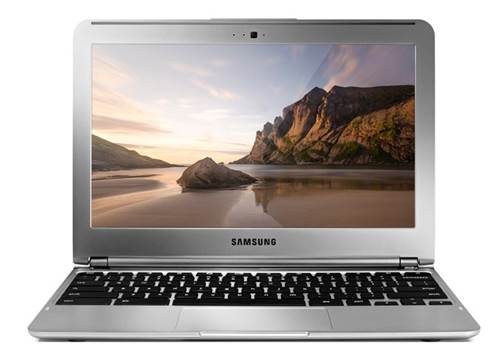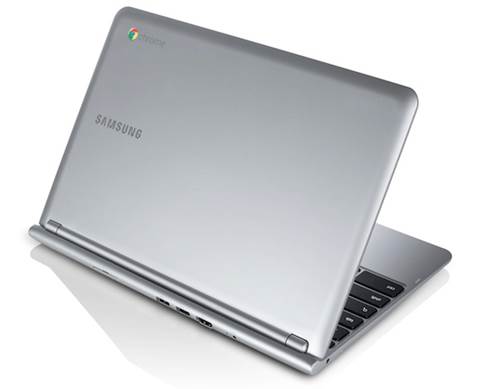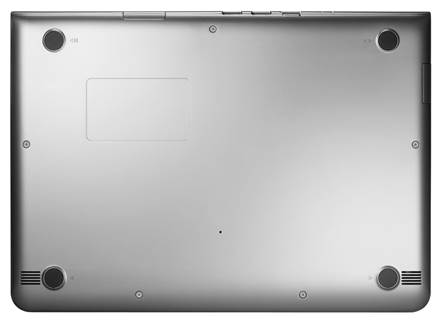Screen and sound
The best thing about the Chromebook’s
11.6-inch 1366x768 screen is an anti-glare surface, which means that glare will
not obstruct you in the next time when you're watching the "Modern
Family" on Hulu. However, the anti-glare surface is not necessarily
equivalent with wide viewing angles. Pushing the screen forward, the screen’s
color will be diluted, which makes you very difficult to read the text or watch
a movie. The brightness is also lower than it was on the previous Chromebook:
200 nits compared with 300 nits. However, neither of these things would be
deal-breakers, you will want to adjust the angle before working with the
Chromebook on your lap.

The
best thing about the Chromebook’s 11.6-inch 1366x768 screen is an anti-glare
surface.
The Chromebook’s two 1.5W speakers are
placed at the bottom side of the machine, very close to the front edge. As you
might imagine, the sound is not very big, but you still might want to avoid
increasing the volume unless you are really unable to hear: the movie dialogues
heard sounds even slightly distorted at maximum volume. As we often see with
the small speakers, the musical instruments such as the electric guitar sounds
particularly jarring, but you can manage to listen with the lighter acoustic
music - especially if you keep the volume at a moderate level.
Performance and battery life

The
browsing experience and performance also beat any tablets - it crushes them
with 677.3ms scores in the web browser benchmark SunSpider.
The excessive price cuts arrive at the
compromises, and we're not just talking about design materials. While Samsung’s
first two of the Chromebooks ran dual-core Atom and Celeron processors, this
third-generation model switched a fanless design with an ARM chip - namely, a
Samsung Exynos 5 Dual (5250) SoC based on dual-core A15. Combined with it is
2GB of RAM, a 16GB built-in flash storage, 802.11a/b/g/n and Bluetooth. It was
due to the lack of any quantitative test scores, this is the best way we can
describe the performance: it lies somewhere between the original Atom-based
Chromebooks and the current Celeron-equipped Series 5 model.
The system did not have any problems when
playing back 1080p content in YouTube and Hulu. However, if you use it longer,
you will find out some small delays in response time, even when doing the
things like opening a new tab. Another problem: the transmission of Netflix has
not supported for this device yet. A Google spokesperson gave the following
message: "We are working closely with Netflix and the support will come
soon. Once you are ready, your new Chromebook will be automatically updated
with the Netflix support. "While we do not have any reasons to doubt the
fact that Google is doing it, but this will be a disappointment for many people
unboxing the original units.
In short, if you are a Chromebook user, you
sacrifice very little to buy it for $ 249 compared to $ 450 other model - in
fact, you get less weight, thinness and improved mobility. You lose the Ethernet
and the 3G radio (it is optional at this time), but you have pre-installed
Bluetooth. But what will happen if you are not a Chromebook user? You should
buy this or a tablet (or even a netbook)? It depends on how much you live in
the cloud. When it comes to entering the texts, the Chromebook is superior to
any tablets (the Transformers even) because of the great keyboard and because
it's more practical than bringing a separate keyboard/dock. The browsing
experience and performance also beat any tablets - it crushes them with 677.3ms
scores in the web browser benchmark SunSpider, for example. Of course, there
are no separate applications.

The
Chromebook’s two 1.5W speakers are placed at the bottom side of the machine,
very close to the front edge.
Meanwhile, netbooks have made much progress
a long way in the comfort of the keyboard and overall performance, but you will
be unable to find anything like this quality for $249. Of course, they have the
advantage of being able to run many heritage Windows applications. However, if
you think that you need the desktop programs, you should not consider a
Chromebook. Also, if you need more local storage than what your SD memory card
can provide. And that has always been the argument for netbooks over
Chromebooks, so actually, except that this time the Samsung’s Chromebook is
priced half. Based on that there are not any similarly pretty netbooks in this
price segment, it is easier to forgive the shortcomings of the Chromebook and
recommend it as a cheap computer in the second position.
In terms of battery life, it obtained six
and a half hours of runtime. Indeed we recorded 6 hours 33 minutes in the usual
battery test, which includes looping a video from a local storage with Wi-Fi
open. It's better than most Ultrabooks we have tested recently, although that
does not say much. Over the past years, the netbooks granted power by the Atom
was able to achieve 10 hours of battery life. Round Windows 8 tablets running
the latest Atom also attained about 10 hours. Not to mention many tablets
running ARM that got 9 or 10 hours - we are talking about the products such as
the latest iPad, the Asus Transformer Pad TF700 and the Surface for Windows RT.
So, while six and a half hours is pretty good, it does not match what you will
probably get from the other cheap mobile devices.